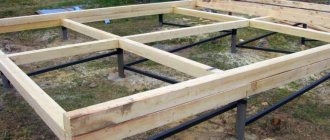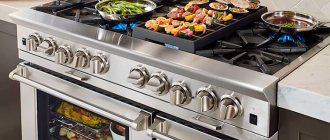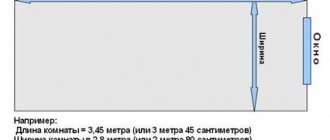Do you want to renovate your kitchen, but don’t know how to properly place household appliances so that they function for a long time, are safe for household members and do not consume more electricity than they should? Agree, you don’t want to wash grease off your appliances every day or pay a lot for light just because the refrigerator and gas stove are too close to each other.
We will tell you how to properly place furniture and appliances to mitigate possible negative consequences. We’ll show you how to protect the refrigerator if the layout does not allow it to be adjacent to the stove.
Rules for the location of the refrigerator and stove
It is recommended to place household appliances in the kitchen according to the “ triangle rule ”. That is, the refrigerator, sink and stove should be located as if in the corners of an isosceles triangle. The optimal distance between zones is from 1.2-2.7 m. Then the devices will not interfere with each other and it will be convenient for the housewife to get food and cook.
Unfortunately, kitchens are often small in size and appliances have to be placed almost end-to-end. Next, we will look in more detail at whether it is possible to place a refrigerator near a gas stove and whether there are generally accepted requirements for placement.
In the layout of many apartments, no more than 5-6 square meters are allocated for kitchen arrangement. m. In such conditions, it is not always possible to place a refrigerator and stove according to the recommended rules
Distance standards between household appliances
All refrigerators differ in power, type of freezing and degree of thermal insulation. Manufacturers must indicate in the instructions the recommended distance for installing equipment from the gas stove. For example, a Zanussi brand refrigerator is mounted from a gas stove at a distance of 50 cm.
If the instructions are lost, then, according to regulations, the minimum distance from any refrigerator to a household gas stove should be 25 cm or more. Ideally, you need to place a table between the equipment.
Bosch refrigerators have multi-layer thermal insulation. They can be installed at a distance of 30 cm from a stove with gas burners and 3 cm from an electric hob
You can install a small cabinet between the refrigerator and the gas stove. Pots won’t fit in it, but it’s convenient to store small things in the form of sponges, various brushes and household chemicals.
Due to the fact that many furniture companies produce cabinet furniture to order, you can easily “disguise” the recommended gap of 25 cm. Thus, they make storage sections or the same cabinets according to individual sizes.
We also recommend that you familiarize yourself with the rules for placing a refrigerator near a gas pipe.
Consequences of close proximity
The gas stove does not have insulation, so during its operation, nearby surfaces heat up.
If the wall of the refrigerator heats up, it will not defrost, it will not work worse, and the food in it will not spoil. However, the compressor of the unit will turn on more often and work for wear . Such a load will negatively affect the service life of the device.
Disadvantages of close proximity of the stove and refrigerator:
- rapid formation of ice inside the refrigerator - due to heating, the compressor begins to cool more intensely, as a result, the ice freezes faster;
- frequent washing of the walls of the refrigeration appliance - during cooking, splashes of fat may fly away, which are subsequently difficult to remove from the metal surface;
- heating deteriorates the appearance of the refrigerator - the paint swells and turns yellow, plastic handles crack or melt, as well as door frames;
- end of warranty - many manufacturers write in the instructions that the refrigerator should not be installed near a stove, oven or heating appliances; even the minimum permissible distance between household appliances is indicated;
- increased energy consumption - the compressor often turns on and the device operates at full power.
In addition, if the refrigerator is located right next to each other, then it is not very comfortable to use a gas stove, since you can only approach the hob from one side.
With the stove and refrigerator close together, there is almost no free space left. This is not practical, since the handles of frying pans and other utensils will rest against the wall of the refrigeration unit
If you still have to place household kitchen appliances nearby, then you need to take care of additional thermal insulation of the refrigerator wall.
Conflicting opinions regarding distance from the wall
The need to maintain clearances from the wall, not only from the back, but also on the sides, is recognized by almost all experts. Non-technical people may argue that this measure is not at all necessary, or suggest that the main air movement can be sufficient if a significant space is left above.
If you do not take into account that modern refrigerators are quite tall, and even if you leave a large, unoccupied piece of space on top, this will not help much in ensuring safety.
People are sure that 4 centimeters is enough, and a larger distance is required for normal opening of the door, and a space left at the back of 10 cm will fully ensure normal functioning. However, now it is impossible to make any categorical statements, as it was before, when the variations of models were not particularly diverse.
Today, there are the most variable models of units, ranging from a built-in refrigerator located directly in the kitchen wall or in furniture, and up to a multifunctional device with numerous automated functions.
Even a carefully measured distance and ideal location according to the parameters does not answer whether it is possible to install newly purchased household appliances in it. Basic placement parameters should be found in the instructions for the household electrical appliance.
When studying the recommendations from the manufacturer, it turns out that both debaters are right. It’s just that each of them talks about different types of devices belonging to different classes and years of manufacture. To prevent the repair of a brand new unit from becoming a severe necessity in the first months of operation, the instructions for it must be studied in advance:
Vinyl wall panels for brick look for exterior home decoration
Experts say that ventilation must certainly be carried out from the back, where the main part of the functioning devices is removed, and from above. There are examples when, for a very tall device that left a gap between the lid and the ceiling of only 3 centimeters, it was necessary to organize an air suction into the outlet for the air conditioner.
This is because, trying to save centimeters in width, the buyer did not take into account that the manufacturer’s instructions require leaving at least 9 cm above the refrigerator. Therefore, there are many recommendations to study what is stated in official documents not after the purchase, but shortly before it.
Ways to protect your refrigerator
When it is not possible to leave the recommended gap between the devices, you need to make your own partition from a material with insulating properties. Both organic and inorganic materials can be used as thermal insulation separating the refrigerator from the gas stove.
Organic options: reeds , cork sheets , textolite , chipboard . These materials are moisture resistant and can be used as insulation. But it is worth remembering that with prolonged heating they can become deformed.
Inorganic heat insulators:
- fiberglass;
- asbestos cardboard;
- isolon;
- mineral wool;
- drywall.
The materials have high heat-insulating properties. The only thing is that they can lose their quality when exposed to moisture, so they are not installed next to the sink.
Thermal insulation materials are sold in the form of rolls or small sheets with a thickness of 5 millimeters or more and a width of 75 centimeters. The insulation is easily cut into strips; before gluing it must be leveled
On one side, the rolled thermal insulation has a self-adhesive surface, and on the other, it is covered with a lavsan film. The material should be glued from top to bottom onto the entire surface of the refrigerator wall.
There is no self-adhesive layer on sheet insulation. It is recommended to use double-sided tape to secure it. It holds sheets well and can be easily removed when it is necessary to replace the material.
Instructions for making a protective shield
Shields are used to separate the refrigerator from the gas stove. Thermal insulation can be made from various materials, for example, chipboard. The plates have high rigidity, so they do not need to be glued to the surface of the devices.
Option #1 - thermal insulation with chipboard
A chipboard will help protect the refrigerator from the effects of a gas stove. Install it between household appliances and the stove.
The side cuts of the shield must be covered with adhesive tape. Otherwise, different-sized chips will be visible in the structure. In addition, in places where cuts are not closed, the material is difficult to wash. Therefore, the ends are covered with decorative film or laminated. You can order this service at places where sheets are cut.
It is better to buy laminated chipboard. There are many color options for this material. You can choose the color of the shield that will match the color of the furniture and match the design of the kitchen
On average, thermal insulation made from chipboard lasts for three years. Afterwards, the appearance is lost, as moisture and heat destroy the structure of the material. But since such thermal insulation is inexpensive, it can be changed at least annually.
Option #2 - constructing a shield from tiles
It looks beautiful and is easy to clean – these are the main advantages of a thermal insulation board made of tiles. It fits optimally into the kitchen design, especially if it matches the style and color of the “apron”.
If moisture gets on the drywall, it will begin to deteriorate. Therefore, when laying tiles, carefully cover the cracks.
The tiles are glued to the shield using special glue. You can lay the tiles on a sheet of chipboard, moisture-resistant plasterboard, OSB boards, and also QSB
Option #3 - making a mirror screen
Mirror surfaces reflect heat well. Mirror, glass or foil can be used as the main thermal insulation material. Attach the insulation to the partition using glue.
A partition with foil is thinner than other thermal insulation options. To improve the protective properties, you can glue the material onto a thick shield. Then the mirror screen will be durable and last longer.
A foil screen will be quite expensive. However, it is able to reflect heat better than regular cheap insulation. This means that the refrigerator will not heat up and will last longer.
The only disadvantage of such insulation is mirror reflection, but this can be removed if corrugated glass is placed on top.
What to do if there is no other way out
When purchasing a refrigerator, a reasonable person immediately decides on the space that can be allocated for this in the kitchen. A thoughtless purchase often leads to the unit being moved into the living room or hallway. There are models no more than 50 cm wide, they take up less space than standard ones, and there is no need for close proximity. Sometimes, in order to purchase a coveted device, owners buy a mini-stove or a small sink, which also causes some inconvenience.
Unit from the stove
In a limited space, it is necessary to clearly calculate the options for the location of the most necessary things, and take into account natural factors - natural air circulation, sunlight and possible heating. The need to constantly wash the wall located near the stove is not the only trouble. There is also inconvenience in using frying pans with handles, large pots, as well as harm from exposure to moisture due to boiling liquids, of which water is the most harmless.
Additionally
People have come up with many ways to avoid damaging heat - placing an insulating sheet or partition between two kitchen attributes, or lining the unit itself from an insulating material.
For this, wood, tape, drywall, and polymer materials are used.
Large distance to the stove
But as soon as it gets warmer outside, you have to take the next step - installing a hood above the refrigerator. Because the heat rises and warms its lid. The price of such a device is much higher than what was originally planned for the purchase of the refrigerator itself, especially when you consider the time spent on construction and acquisition. So you should think through all possible options in advance and choose the best one for yourself.
Ideas for optimal refrigerator placement
If the kitchen is small, then the refrigerator can be installed outside it, for example, placed on a loggia or in a pantry. Some apartment owners place such large equipment in the hallway.
In Khrushchev-era apartments, not only the kitchens, but also other rooms are small. The option of installing a refrigerator in the hallway is eliminated. But in such apartments the interior walls are not load-bearing. If desired, you can choose a suitable refrigerator and build a niche for it in the partition between the living room and kitchen.
The ledge in the living room is decorated or used as a shelf. It is also convenient to place a washing machine in the free space.
When choosing a place for a refrigerator, do not forget that the device cannot be installed not only near the stove, but also near radiators, as well as other heating devices.
An example of the correct arrangement of household appliances. Even in a small kitchen, you can install appliances so that they do not interfere with each other
If it is impossible to move household appliances to another room, then you need to take care of a good hood in the kitchen. It must be powerful enough to capture as much convective currents from the gas stove as possible.
A good option for a small kitchen is a built-in refrigerator. The surfaces of such a device are covered with chipboard or MDF boards. The frame of the box will not only protect the unit from heat, but will also insulate the metal walls from dirt and grease splashes. To improve the thermal insulation properties, foil or other insulation can be glued to the surface on the side of the gas stove.
A powerful hood and proper placement of appliances will not only extend the life of household appliances, but will also optimally complement the design of even a small kitchen
If there is very little space in the kitchen and it is not possible to redesign the room, then you can install a mini-fridge. It is lower than standard models, so you can install an oven or microwave on top. The main thing is not to forget about the rules of thermal insulation of devices
Replacing full-size equipment with smaller versions will help you gain some free space. For example, you can install a stove with two burners. This will increase the distance between the stove and the refrigerator to 15-20 centimeters.
There are also narrow refrigerators on sale, their width is about 55 centimeters. Of course, this is an expensive solution to the problem.
Sometimes it is better to make a small remodel in the kitchen, install a smaller sink or move the stove to another place. Even a few centimeters of free space will improve the situation.
Fighting greasy stains on walls
These marks may seem easy to remove once cooking is finished. But often owners are too lazy to start cleaning right away. Why do the drops begin to solidify? The appearance of the snow-white walls of the refrigerator inevitably deteriorates.
But the enamel on the walls of the appliance is more delicate compared to the tile itself. To get rid of dirt, do not use rough metal brushes. Therefore, you will have to constantly monitor the appearance of greasy marks in order to remove them immediately. It is unlikely that any housewife would be satisfied with such a turn.
Of course, sometimes the situation develops in such a way that it is simply impossible to find other solutions. There are ways to protect yourself from fat, but it is better to avoid such situations altogether if possible.
Conclusions and useful video on the topic
You can see ideas for placing a refrigerator and a stove in a small kitchen in the video below:
Manufacturers of household appliances do not recommend installing a refrigerator and a household gas stove next to each other; the ideal option is in different corners of the room.
The distance between appliances depends on the refrigerator model. The minimum is 25 centimeters. But not every kitchen can afford such placement.
Therefore, in the article we examined existing options for thermal insulation of refrigerators, which can protect against the negative consequences of overheating.
How did you decide to place these two extremely important types of household appliances in your kitchen? Share interesting ideas with other users, add photos of your kitchen, participate in discussions, ask questions - the contact form is located below the article.
Consequences of overheating
Constant operation at elevated temperatures leads to serious technical problems. Overheating causes:
- increasing the operating time and reducing the rest period - excessive energy consumption occurs;
- engine failure - the cost of a new engine and its replacement will cost half the price of the refrigerator;
- uneven freezing - affects the quality of products;
- leakage of the unit - the temperature inside the refrigerator rises;
- reducing the shelf life of food;
- thermostat failure;
- fire.
Due to the constant interaction of cold and hot air behind the unit, condensation accumulates, and then mold appears. The walls are deteriorating.











